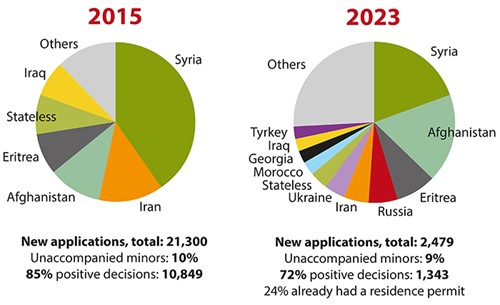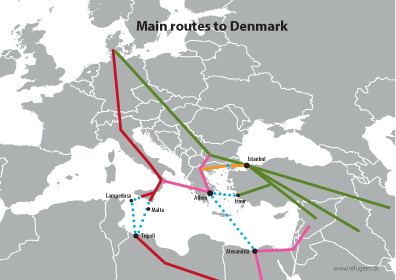How many are coming, and from where?
Current numbers
During the first 11 months of 2024, 2,176 asylum applications have been registered. But 370 of them are "remote registrations", meaning people who already had a legal permit to stay in Denmark on other grounds, which brings the number of new arrivals down to 1.870. All of last year, a total of 2,482 applied for asylum in Denmark, whereof 24% were remote registrations, and only 1,670 cases were in fact opened in Denmark. These years, a similar number are returned to other countries or accepted back to Denmark following the Dublin procedure. At the moment, 2,300 asylum cases are pending.
The numbers are surprisingly low when considering that 25,000 arrive every month in Germany these days. Denmark is no. 23 on the list of asylum seekers per capita in EU. In all of EU there are around 900,000 pending asylum cases which is the highest in many years. Germany alone received 329,000 in 2023 and have a hard time coping with the pressure. On top of this, more than 4 million Ukrainians have arrived in Europe, and once again, Denmark has received fewer per capita than for instance Sweden and Norway.
In 2022, the number of new cases in Denmark was higher: 4,591, but only 1,007 were processed. Almost half were Ukrainians whereof many have later dropped the application, and around one hundred were evacuated Afghans. In 2021-22 almost 900 permits were given under the Special Act for Afghans. At least 270 evacuated Afghans have left the country afterwards as they were welcomed in UK or the US. The ones who stayed have later asked for asylum when their permits expired, and have been granted it.
Almost 50,000 Ukrainian cases have been processed the Special Act for Ukrainians. Almost all have been granted stay and also had it extended. They have not been accommodated in the asylum system, but stayed in private homes or directly in the municipalities. 7-8,000 have left Denmark again. Just under 1,200 have been rejected under the Special Act, and 650 Ukrainian asylum cases are pending (but they have been on hold since the war started and the processing has only begun recently).
Today there are 14 asylum camps in total; but the number was as high as 98 in 2015. There are around 2,600 people accommodated in the asylum camps, out of these 450 are staying in one of the deportation camps, and 700 are Ukrainians of which some are passing quickly through the system.
In total, the same number of refugees and their family members (with legal residence) left Denmark as new ones who received a permit to stay. See the numbers here.
NUMBER OF ASYLUM SEEKERS IN DENMARK 2002-2023 (gross numbers)
Usually the gross number is used, though it includes people who will never have their case processed in Denmark, and will only stay a short time in the country. The registration number is more accurate, as that only includes cases that are in fact opened in Denmark, after Dublin negotiations etc. Read more under The Dublin regulation. If all gross numbers for European countries are added together, the number will be much higher than that actual number.
Another important fact is that one in every three or four applicants already have a residence permit, usually via family reunification from Syria or Eritrea ("remotely registrations"), which has made a significant impact on numbers over the last 6-7 years.
Around 25% of the asylum seekers are children under 18 years, and some of them are unaccompanied minors. In 2023, 227 unaccompanied minors came, almost half of them Afghans. Some of the unaccompanied come from Morocco, but they are all rejected and continue their travel. The same young boys occur in statistics in several countries, as they are not transferred according to the Dublin rules.
Development over time
In the light of the massive focus on refugees and the constant discussion about returning them, it might come as a surprise to many that refugees only made up 1% of all foreigners who were granted residence permit in Denmark over many years. The municipalities only received 651 new refugees in 2023. People with asylum as their basis for residence only makes up for 1,9% of the population.
During the last 8-9 years, Denmark has seen some major changes in the arrival of asylum seekers: The number peaked at the end of 2015 with 21,000 new arrivals – but dropped overnight to a very low level where it still is. Lately the system has been dominated by evacuated Afghans and displaced Ukrainians, each group under their own Special Act.
The number of new applications has been historically low in recent years. In 2020, the border closures due to Covid-19 almost put a total stop to arrivals: only 1,515 new applications were filed in total (gross number), which is the lowest number ever registered. In 2018 for instance, the number was 3,500.
Adding to this, Denmark has since 2015 not accepted the 500 resettlement refugees per year from UN which we did through 38 years. During the last 7 years, only 235 quota refugees have arrived in total, coming from refugee camps in Rwanda. Only 1 resettlement refugee was granted a permit in 2023.
The "refugee crisis" 2014-16
The rise that Denmark experienced 2014-2016 was even higher in other parts of Europe, and it was mainly due to new and less dangerous access routes opening up via the Greek islands and then through the Balkan countries. In 2015 more than 1 million refugees came to Europe, which was twice as much as the year before. Both the outer and the inner border controls were intensified, and the number of new arrivals decreased all over Europe, but has risen again.
The all time record in Denmark was October 2015 when 3,694 new applications were filed in one month.
In total, 80,000 people got a residence permit in Denmark in 2016, but only one out of nine was a refugee. The others got permits because of work, studies or family reunification. Since then, the percentage of refugees has dropped even further, to 1 our of 100.
Where do they come from?
In 2024, top 5 nationalities are: Syria, Eritrea, Turkey, Afghanistan, Iran. To see Turkey on the list is very unusual. After 2015, applicants have generally come from a larger number of countries, and fewer people from each country.
The profile of the applicants has changed somewhat during the last 10 years, which affects the number of positive decisions, including the new phenomenon 'remote registrations' which accounts for a large part of the applications in Denmark.
The balance in nationalities applying for asylum in Denmark has changed quite a lot from 2015 to 2023. From 2013-2020, Syrians have made up the largest part, but over the years Afghans have often been number one. In 2014, Eritreans was suddenly number two on the list, dropping to number eight in 2016, and in 2019 rising again to a shared first place with Syria – this is, however, due to the 'remotely registered'.
TOP 5 NATIONALITIES SEEKING ASYLUM IN DENMARK 2019-2023

NATIONALITIES SEEKING ASYLUM IN DENMARK 2015 AND 2023

Main routes to Denmark
Almost everybody who arrives in Denmark to ask for asylum will come illegally – with a smuggler or false papers. It's virtually impossible to get a visa to Europe if you come from countries like Syria, Eritrea or Afghanistan.
The number of asylum seekers in Europe dropped significantly due to border controls around and inside Europe after 2016, but has risen again since 2021. In Denmark, new arrivals dropped even more and have not risen since.
There are still many small boats sailing from Turkey to Greece each month, but relatively more arrive via Libya and Tunesia. It is a much more dangerous route, and many die in the desert of Sahara and drown in the Mediterranean. Increase in patrols and criminalization of rescue efforts has led to a higher percentage of drowned.
The instability and violence in Libya has led to European actors increasingly collaborating with several armed groups in Libyan on border control and the containment of migrants in camps, before they can travel across the Mediterranean. This has made the situation for migrants in Libya even more dangerous. More are therefore attempting to travel over lesser known routes, such as Egypt and Tunisia to Italy.
UNHCR has an interactive homepage where you can see the current numbers of arrivals and drowned.
The pattern and number of arrivals change every year, but Italy, Greece and Spain are the main arrival points, in that order. In total, 288,000 people arrived in 2023 to EUs external borders.
Arriving at the border of Europe means new obstacles – violent border patrols and illegal push backs have become increasingly normal. In Greece and Italy it's almost impossible to survive as a refugee, and many end up in destitution on the streets. The Dublin regulation is also a challenge. All the way through Europe fences and control posts have been put up, making it very difficult to reach as far as Scandinavia. Thousands are stuck in Lesbos and Bosnia under inhuman conditions.
Read a personal story of a journey in 2014 from Eritrea to Denmark: The road to freedom goes through Hell.
Were you happy to find these facts?
Give us a donation to keep up our work!



